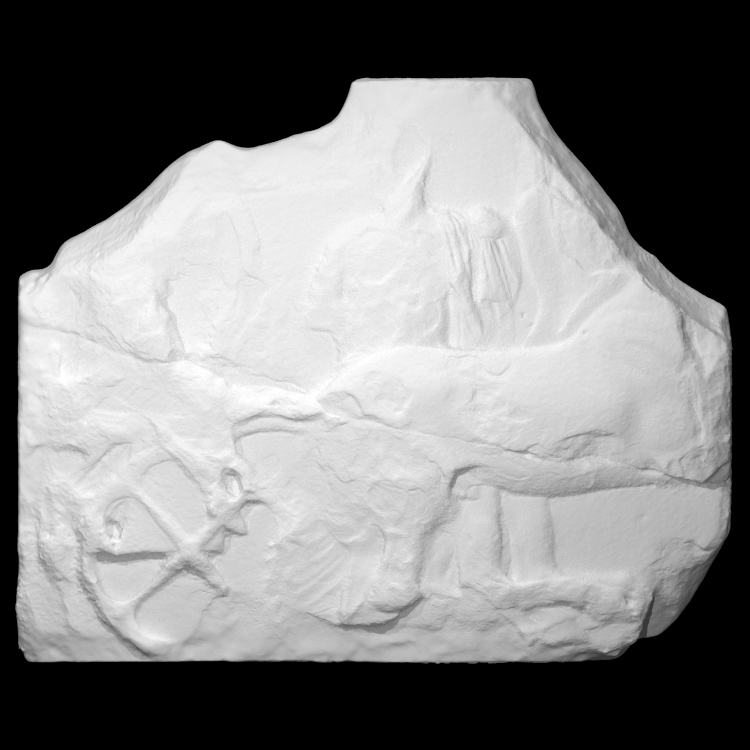
Parthenon Frieze _ South XXXII, 80-81-82
myminifactory
Block XXXII displays a chariot, a marshal, and within the carriage lies the remains of a soldier and a charioteer. The soldier grips a large round shield firmly on his left arm. Beneath, the carriage of the chariot and the hub of a wheel are visible. Metal reins, now lost, were inserted into drill-holes. The south side of the frieze is only partially preserved due to its badly damaged state following the massive catastrophe caused by the explosion in 1687. This destruction makes the sequence from block XX uncertain. However, the Carrey drawings provide valuable insights into many of the missing sections and have enabled us to locate a number of existing fragments. The original length of the frieze along the south side was 58.70 meters. It consisted of forty-seven blocks, with some exhibited in the Acropolis Museum, others in the British Museum. Each block averages 1.22 meters wide. The overall workmanship is clearly less skilled than that of the north frieze, although some scenes may be considered masterpieces of the Parthenon (blocks III, X, XI, XXVI, XXXI, and XLIV). The procession begins at the west corner and moves to the right. Unlike the north frieze, there is a lack of variety in pose, garment, and movement among figures and animals here. The riders move in a straight line, looking forward, with one exception on block V, rider 13. The horses' trimmed manes reflect their speed. As seen in the north frieze, three sections are evident in the south: a) horsemen, b) chariots, and c) the sacrificial procession. It is likely that the arrangement of horsemen in the procession followed the tribal organization of the Athenian state. The variation in garments supports this interpretation. There are ten groups of six riders each, with different attire. The first group (2-7) wears a fox-hide cap, short chiton, chlamys, and boots; the second group (8-13) only wears chlamys. In the third group, horsemen (14-19) wear a short cuirass over a short chiton and boots. The fourth group (20-25) is clad in short chiton and chlamys, while the fifth (26-31) wears an anatomical cuirass over a short chiton and boots. The sixth group (32-37) wears a fox-skin cap, short chiton over which is a cuirass with flaps, and boots. Those of the seventh group (38-43) wear a helmet of Athenian type, short chiton, chlamys, and boots; the eighth group (44-49) wears chlamys over short chiton and boots. The ninth group (50-55) is clad in petasos, short chiton, chlamys, and boots, while the tenth group comprises horsemen (56-61) wearing short chiton and boots. The procession of chariots follows next, heavily damaged by the 1687 explosion, with only interrupted stretches preserved. Five blocks are missing altogether, and ten chariots are in the course, each taking up a single block. Some chariots stand still (XXVI), some start (XXIX), and others move at full speed (XXXI). The subsequent blocks depict the procession of sacrifice, including thallophoroi with olive branches, musicians with citharas (kitharai), skaphephoroi with offering trays, and animals accompanied by their herdsmen. The frieze of the Parthenon forms a continuous band around the upper part of the cella within the outer colonnade. The theme represented is the procession towards the Acropolis during the Great Panathenaia, which commemorates the birthday of the goddess Athena. Numbering based on I. Jenkins' work "The Parthenon Frieze" (1994). Frieze slabs are marked with Roman numerals; people are marked in Arabic numerals.
With this file you will be able to print Parthenon Frieze _ South XXXII, 80-81-82 with your 3D printer. Click on the button and save the file on your computer to work, edit or customize your design. You can also find more 3D designs for printers on Parthenon Frieze _ South XXXII, 80-81-82.
